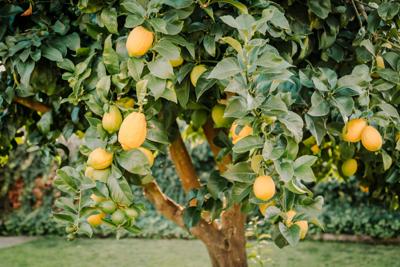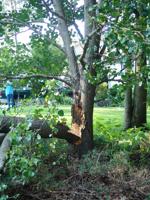While many fruit trees we grow throughout the state, from peaches to apples, tend to have a relatively short lifespan of 20 to 30 years, citrus fruit trees can live up to, and sometimes for more than, 50 years. This makes them a great fruit tree to include in your landscape, especially closer to the coast with milder winters.
In my previous article a couple of weeks ago, I discussed some of the basic concepts of growing citrus in the garden. I discussed the issues surrounding citrus greening and the quarantine for Charleston County. I also discussed cold-tolerance concerns, pollination, as well as the juvenile period for citrus, which limits one from growing citrus from seed. But I did not cover all the information pertinent to growing citrus, so I thought to revisit this group of fruit trees once more.

Some citrus trees can produce rather large thorns, which can be dangerous and must be handled with care. Christopher Burtt/Provided
I mentioned in the previous article that citrus trees, for the most part, have perfect flowers and are self-pollinating. This means that one can have a variety of citrus all in one yard. And of course there are many different types of citrus to choose from, and I wanted to discuss some of the most common ones to grow here.
There are the two more popular species for home gardeners: lemons and lime.
Lemons, Citrus limon, comes in several different cultivars, but the one commonly found here is the Meyer lemon, a hybrid variety that is best suited for the home garden. The fruits are slightly smaller than the more common Eureka lemon but are slightly sweeter.
Limes, Citrus aurantifolia, also has several varieties, but the two most common are the Tahiti or Persian lime and the Key lime. The Persian lime is more difficult to produce a consistent crop than the Key lime. The biggest issue for both lemons and limes is they are the most susceptible citrus to frost damage. This means proper frost protection is key or selecting from one of the more cold- tolerant species.
There are several cold-tolerant species of citrus. Generally considered one of the most cold-tolerant citrus trees, the Satsuma or Satsuma mandarin, is cold-hardy down to 15 degrees Fahrenheit. when mature. The Satsuma is fairly vigorous but tends to be more a dwarf citrus tree. This makes it an excellent choice for smaller landscapes.
The grapefruit tree, Citrus paradisi, is another of the more cold-tolerant trees. A relatively new hybrid, the grapefruit produces large, yet flavorful, fruit that comes in both red and white. But according to most sources, the most cold-tolerant citrus tree is the small-but-productive kumquat. While often overlooked, this small tree only gets to around 15 feet tall and is cold tolerant down to around 10 degrees Fahrenheit. This makes it one the best choices for the home gardener here in the Lowcountry.
But speaking of fruit trees such as grapefruit, there is one thing I must mention about citrus that is important to remember when deciding where to plant them. Some citrus trees do produce thorns. And when I say thorns, this does not mean the small but prickly thorns of something like a rose. Some citrus trees can produce rather large thorns, which can be dangerous and must be handled with care. As I mentioned previously, most citrus is grown grafted onto suitable rootstocks. When these trees are killed back by the frost, the rootstock may grow back. Most of the species used as rootstocks, unfortunately, tend to have the largest thorns.

Citrus leafminers can burrow under the leaf's surface and begin to feed, causing streaks that can disfigure the leaf. Christopher Burtt/Provided
Citrus overall is a fairly problem-free crop to grow, but there are some issues to look out for. There is one insect I wanted to mention, as it is one of the more common problems when growing citrus: the citrus leafminer, a small insect that burrows under the leaf surface and begins to feed. This leaves streaks that can disfigure the leaf and become unsightly. Leafminers are, for a lack of a better word, a minor issue. The damage done by these insects rarely affects the overall growth and production of the tree. That being said, young citrus may be more vulnerable to leafminers.
If you are interested in learning more about fruit or just growing edible plants in general, please feel free to check out the Edible Garden Series, which is a free, monthly series of presentations on the different aspects of growing plants for food. On Aug. 30, there will be a discussion on fall vegetables, followed by a talk on harvesting and preservation on Sept. 10. I will be going into all about fruit in October. For more information, reach out to me at cburtt@clemson.edu or check out the Charleston Cooperative Extension website, www.clemson.edu/extension/charleston/index.html, for links to sign up.













